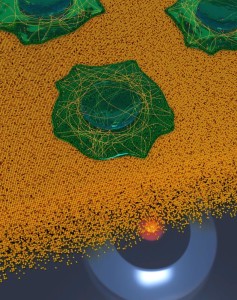pte20220622027 Technology / Digitization, Research / Development
Göttingen scientists combine two different methods already known
 |
|
Image of cells on a gold surface (Photo: uni-goettingen.de, Alexey Chizhik) |
Göttingen (pte027/22.06.2022/12:30) –
Researchers led by the University of Göttingen http://uni-goettingen.de They have investigated an ultra-high-resolution imaging technology that combines the advantages of two different methods. This enables ultra-high-resolution 3D imaging at the nanometer scale. Details were published in “Science Advances”.
Rental and dSTORM
Metal-induced energy transfer (MIET) was used. The exceptional depth resolution of MIET imaging combined with the exceptional lateral resolution of microscopy of single-molecule localization, particularly with a method called direct stochastic optical reconstruction microscopy (dSTORM), enables 3D super-resolution of subcellular structures.
In addition, the researchers used the two-color MIET-dSTORM technology to 3D image two different cytoskeletons, such as clathrin-coated microtubules and pits, which are small intracellular structures that coexist in the same region. “By bringing together well-established concepts, we have developed a new technique for super-resolution microscopy,” says lead author Jan-Christoph Thiel.
Simple and Versatile
The range of applications of the new powerful tool is very wide to solve protein complexes and small organelles with sub-nanometer precision. Co-author Oleksii Nevskyi adds: “Anyone with access to a confocal microscope with a fast laser scanner and the ability to measure fluorescence lifetime should try this technique.”
(End)


“Problem solver. Proud twitter specialist. Travel aficionado. Introvert. Coffee trailblazer. Professional zombie ninja. Extreme gamer.”



More Stories
With a surprise in the case: a strange cell phone from Nokia was introduced
PlayStation Stars: what it is, how it works and what it offers to its users | Sony | video games | tdex | revtli | the answers
t3n – Digital Pioneers | digital business magazine